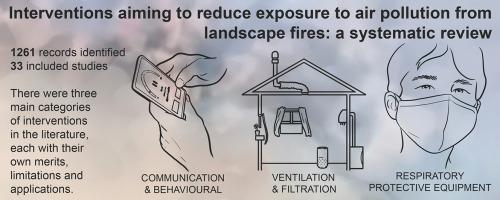Interventions for reducing exposure to air pollution from landscape fires in a changing environment: A systematic review
IF 8
1区 环境科学与生态学
Q1 ENVIRONMENTAL SCIENCES
引用次数: 0
Abstract
Emissions from more frequent and prolonged landscape fires (wildfires, risk reduction fires, agricultural burning) can expose populations to high levels of air pollution and exacerbate a range of health conditions. This systematic review aims to map, evaluate, and synthesise the scientific literature reporting interventions that can reduce exposure to landscape fire smoke (LFS).
Using the Preferred Reporting Items for Systematic Reviews and Meta-Analyses (PRISMA) guidelines, we searched PubMed, Scopus and Web of Science and reviewed relevant literature published until March 2024.
Thirty-three studies from four countries met the eligibility criteria. Of the interventions evaluated, air filtration was the most frequently reported, and included use of portable air cleaners (PACs) with high efficiency particulate air (HEPA) filters, ventilation systems with standard and upgraded filters, and low-cost fan filter units (FFU). The effectiveness of PACs for fine particulate matter (PM2.5) reduction ranged between 54 %–92 %. In naturally ventilated residences, concentrations of PM2.5 were 0–44 % lower indoors, and depended on the duration of LFS, building operation, and permeability. Mechanical ventilation with minimum efficiency reporting value (MERV) 5/8 filters in buildings reduced LFS PM2.5 levels by 18–58 %; however, use of higher rated filters (e.g., MERV 12/13) achieved reductions of up to 87 %. Communication interventions, including smartphone apps and alerts/messages from various media sources (e.g., radio, television, internet) had mixed results; nevertheless, inclusion of spirometry and asthma control surveys during app use could improve health outcomes for vulnerable groups. The efficacy of facemasks (N95/P2) was up to 94 % for single pass PM2.5 removal, although they were relatively underutilised. Clean air shelters in public buildings can potentially provide a place for exposure reduction and social support, but have not been sufficiently tested during LFS events.
Further research is needed on the effectiveness of interventions during prolonged smoke events, and in low- and middle-income countries.

在不断变化的环境中减少景观火灾造成的空气污染的干预措施:系统综述
更频繁和更长时间的景观火灾(野火、减少风险火灾、农业燃烧)所产生的排放可使人口暴露于高度空气污染中,并使一系列健康状况恶化。本系统综述旨在绘制、评估和综合报道可减少景观火灾烟雾暴露的干预措施的科学文献。我们使用PRISMA (Preferred Reporting Items for Systematic Reviews and meta - analysis)指南,检索PubMed、Scopus和Web of Science,并回顾了截止到2024年3月发表的相关文献。来自四个国家的33项研究符合资格标准。在评估的干预措施中,空气过滤是最常被报道的,包括使用带有高效微粒空气(HEPA)过滤器的便携式空气净化器(PACs),带有标准和升级过滤器的通风系统,以及低成本的风扇过滤装置(FFU)。pac减少细颗粒物(PM2.5)的有效性在54% - 92%之间。在自然通风的住宅中,PM2.5浓度在室内低0 - 44%,这取决于LFS的持续时间、建筑运行和渗透率。在建筑物中采用最低效率报告值(MERV) 5/8过滤器的机械通风将LFS PM2.5水平降低了18 - 58%;然而,使用更高额定的过滤器(例如,MERV 12/13)实现了高达87%的减少。通信干预措施,包括智能手机应用程序和来自各种媒体来源(如广播、电视、互联网)的警报/信息,结果好坏参半;然而,在应用程序使用过程中纳入肺量测定和哮喘控制调查可以改善弱势群体的健康状况。口罩(N95/P2)单次去除PM2.5的效率高达94%,尽管它们的利用率相对较低。公共建筑中的清洁空气庇护所可能提供减少接触和社会支持的场所,但在LFS事件期间尚未得到充分的测试。需要进一步研究在长时间吸烟事件期间以及在低收入和中等收入国家采取干预措施的有效性。
本文章由计算机程序翻译,如有差异,请以英文原文为准。
求助全文
约1分钟内获得全文
求助全文
来源期刊

Science of the Total Environment
环境科学-环境科学
CiteScore
17.60
自引率
10.20%
发文量
8726
审稿时长
2.4 months
期刊介绍:
The Science of the Total Environment is an international journal dedicated to scientific research on the environment and its interaction with humanity. It covers a wide range of disciplines and seeks to publish innovative, hypothesis-driven, and impactful research that explores the entire environment, including the atmosphere, lithosphere, hydrosphere, biosphere, and anthroposphere.
The journal's updated Aims & Scope emphasizes the importance of interdisciplinary environmental research with broad impact. Priority is given to studies that advance fundamental understanding and explore the interconnectedness of multiple environmental spheres. Field studies are preferred, while laboratory experiments must demonstrate significant methodological advancements or mechanistic insights with direct relevance to the environment.
 求助内容:
求助内容: 应助结果提醒方式:
应助结果提醒方式:


